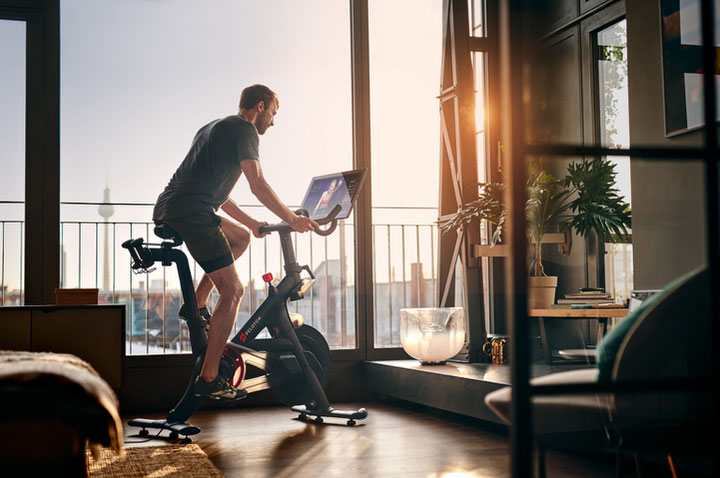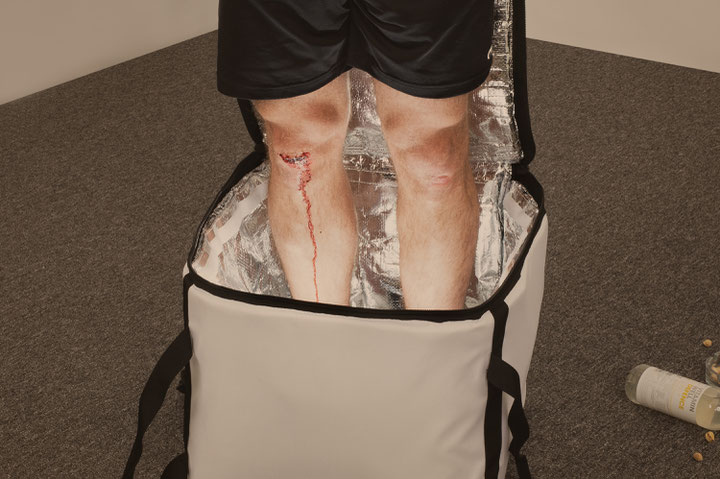Issue 4/2020 - Net section
Give it All You’ve Got!
Some reflections on how the pandemic has changed the world of work
“Hey, Sandra in Munich!”, “Max in Berlin! Let’s go!”, “Give it all you’ve got!” Anyone who launched the YouTube player in spring 2020, in the early days of the restrictions sparked by the coronavirus pandemic, could immediately find themselves (at least in Germany) assailed by the advertising barrage of US fitness start-up Peloton1, which has been trying to gain a foothold in the German market since 2019. The up to 30-second-long clips2 produced by Hamburg-based advertising agency Kolle Rebbe for the Peloton fitness exercise bike, which can be operated in networked mode, touted the device as “your ultimate live home cardio workout”. Using a touchscreen display permanently installed on the Peloton bike, the user looks directly into the eyes of the trainer, selected according to the “Choose Your Fighter” principle, who is sitting on the same indoor bike in the London studio. The trainer – at least, this is the company’s ideal – dictates personalised “Keep it up!” motivational formulas to hundreds or thousands of customers pedalling away while watching the paid livestream at home, for example in their Berlin-Mitte condo (floor-to-ceiling windows, TV tower view).
The principle of networked indoor cycling is not so new, but this advertising campaign (in contrast to the more usual ‘spinning’ sessions, where the machines are operated together in a fitness centre) explicitly relied on the home as a venue for exercise. It thus struck at a time3 when colleges, employers, sports clubs, or television networks were scrambling to make up for sessions in gyms and schools that people were missing by providing daily “power workout” exercise classes on YouTube, Zoom, etc., while maintaining the performance and work capacity of people now stuck at their desks on a huge scale. In particular, the interlocking of live networking via stream (“absolute top trainers, an infectiously enthusiastic community, rousing playlists”4), sedentary physical activity in front of a screen and being confined to one’s own living quarters as the only necessary/possible place of activity make the Peloton clips an annoying, as unavoidable, visual metaphor for one’s own work (place) situation during the coronavirus pandemic. The whole thing resembled the process that two years earlier had turned rental bicycles used according to the bike-sharing principle into a symbol for mobility in platform capitalism.
That means it would be no coincidence if the bicycle, of all things, were to become the fetish of a not so remote vision in which all work would be done at home on a networked exercise bike.5 But who – apart from steam-punks – would have thought that the end of globalization-as-we-knew-it would be marked by a return to physical labour for the purpose of simultaneously securing immaterial labour with one’sown body? And to boot –E. M. Forster’s The Machine Stops may have been one of the most (re)read science fiction stories of the year – that each of us would be doing this in our own cell?
Yet, for decades, our current and future work situation had been described quite differently in terms of bodies and space. Just think back: in the 1990s, shortly after “cyberspace” and “telework” slogans became mainstream, physical training was considered irrelevant. “In cyberspace, there is no need at all to be burdened with such a body as we possess in physical space. Conditioning on a unitary and unchanging body will fall away and be replaced by the notion of the ‘interchangeable’ body. “In CYBERSPACE, there is no need to move about in a body like the one you possess in physical reality. […]your conditioned notion of a unique and immutable body will give way to a far more liberated notion of ‘body’ as something quite disposable”.6 And: “Telework is not an institution, but a constitution”,7 Agentur Bilwet proclaimed in 1997 – although one’s constitution and upstream conditioning were only envisioned in mental terms: “Physical exertion, collegiality, a pushy mentality, displacement, noise and dirt will vanish”.8 (In reality, today, on the Peloton: aching “back” and tinnitus, loud commands,9 pizza boxes piling up beside you).
Although this role ascribed to the body has since been revised (think of Jonathan Crary’s notion of sleep as anti-capitalist resistance)10, until 2019 it was still taken for granted that at least the physical space of (precarious/creative) labour was largely interchangeable. The analysis that the office environment in particular best embodied the mode of production of immaterial labour – and in such a way that the geographical and physical location of the office knew no boundaries – was the critical standard. Whereas last year Silvio Lorusso was still asking “How did hotel rooms, cafes, trains and bookstores become informal workplaces?”11, under lockdown conditions this was inverted into the future research question, “How did hotel rooms, cafes, trains and bookstores actually cease to be informal workplaces?”12 According to Peloton, the answer is: by mutating the home into a 3D environment.
It is strange, to say the least, that the characters of the real-life Peloton trainers are described on the company’s website as if they were avatars. This obviously adheres to a logic already tested in 3D environments since the 1990s, so that what is actually remarkable is how the pandemic now has not only helped shift the workplace environment en masse into the residual exclusively private sphere for an unforeseeable period of time, but likewise turns this private realm into a real-world example of bicycle training tracks previously tested in 3D environments. And so suddenly you find yourself sitting at home on the saddle in front of the screen in the kind of “cyberspace” conceived in the 1990s: In 1999, architecture and media arts professor William J. Mitchell wrote in his essay “Replacing Place” that cyberspace was reinventing the body, architecture, and the complex relationship between them that could be described as “populating space”. He made this point in a number of projects that deploy an artist-designed interface, including Ken Goldberg’s Telegarden and Mitsubishi Electric Research Labs’ (MERL) 3D environment Diamond Park13 – a “virtual community for learning, working, and playing”, designed by artists Ilene Sterns and Stephan McKeown.
How it started – how it’s going. Reading Mitchell’s description of the MERL project, you might well wonder if he’s talking about Diamond Park in 1995 or foreseeing Peloton in 2020: “Diamond Park is physically engaging; when you go uphill, you have to pedal harder, and you can get quite a workout exploring the whole terrain. As you cycle around, you encounter others – represented as three-dimensional animated avatars – doing the same thing. (Actually of course the real people that they represent are all at their own stationary bikes hooked to computers elsewhere on the network.) When they are close enough to be within earshot, you can speak to them and hear their responses. You can even race them round a virtual velodrome”.14
And indeed, in a presentation video by Mitsubishi Electric Research Labs from November 1995, viewers can see, inter alia, accompanied by the motto “Tour de Technology”, several people pedalling on some kind of indoor cycling devices and pitting their simulated cycling avatars against each other in front of monitors on a computer-animated bicycle race track.15 While the similarity to the Peloton clip is by no means striking, the question immediately arises as to whether “Peloton” is an inevitable development that was already inherent in Diamond Park (as a virtual work environment) but only developed its true symbolic power in pandemic times. “Loneliness is [...] a neglected factor in the economy. [...] But loneliness is now so widespread it has become, paradoxically, a shared experience”16, as Alvin Toffler asserted back in 1980. At the very least, the “Peloton principle”, understood as a work principle, establishes a top-down correspondence for all those who can afford the requisite hardware to all those who have had to afford the principle of data-controlled lonely cycling for years.
In this sense, it is no coincidence that artistic works in recent years have chosen the bicycle as a motif or object for critical commentary on aspects of the digitally networked, unregulated service industry, monetization of user data, aspects of crowdsourcing, and the gig economy. Sebastian Schmieg’s Gallery.Delivery17 project comes to mind, among other examples; in this work, since 2018 he has had multiple group exhibitions delivered to homes – so far in Berlin and Milan – using a courier backpack after they have been ordered online. The category would also include – albeit with something of a hindsight perspective –Aaron Koblin and Daniel Massey’s Internet work Bicycle Built for Two Thousand18 (2009), in which the artists commissioned (for $0.06 each via the web service Amazon Mechanical Turk) over 2,000 voice recordings imitating short sound bytes of a song from people from 71 countries, who thus, unknowingly – when the snippets were edited together – formed a chorus of the underpaid.19 And Aram Bartholl’s installation Unlock Life 20 (2020), in which rental bicycles (and e-scooters) salvaged from the bottom of the Spree in Berlin were distributed around the exhibition space with their now mossy green, military-style appearance,21 should be mentioned as one of the most recent works in this vein (it would even tie in with the “Nature is healing” meme).
When one day the pandemic is over, will masses of mossy Peloton bikes be recovered from the Spree? “Hey, Sandra in Munich”, “Max in Berlin! Let’s go”, “Give it all you’ve got!”.
Translated by Helen Ferguson
[1] https://www.onepeloton.com
[2] https://www.youtube.com/watch?v=frvafnnnqZs
[3] “In the third quarter alone, Peloton increased revenue by more than 60 percent to $524.6 million. The number of customers increased by almost 100 percent to 886,100.” Ingo Rentz, Peloton macht gemeinsame Sache mit dem DFB, Horizont.net, Monday, 7th September, 2020; https://www.horizont.net/marketing/nachrichten/fitness-startup-peloton-macht-gemeinsame-sache-mit-dem-dfb-185550.
[4] GPRA News: Achtung! Gewinnt US-Fit-Tech Unicorn Peloton; 12th Sept, 2019; https://www.gpra.de/news/achtung-gewinnt-us-fit-tech-unicorn-peloton.
[5] The (discussions about) pop-up bike lanes in Paris, Berlin or Vienna look rather different in this light, namely as outdoor training tracks for networked indoor cycling.
[6] To cite the software entrepreneur Eric Gullichsen, quoted in Paul Virilio, The Art of the Motor, in: J.Der Derian (ed.), The Virilio Reader, pp. 152–165.
[7] Bilwet Agency, Elektronische Einsamkeit: Was kommt, wenn der Spaß aufhört? Cologne: Supposé 1997, p. 15.
[8] Ibid, p. 14.
[9] “The word ‘Peloton’ was repeated constantly during the session. The whole thing actually felt like a cult. Over and over Jenn called out the brand name – when I finally started counting along, I heard the word ‘Peloton’ eleven more times”. Nicole (@nicole_scooter): Der Peloton-Hype: Studio-Kurse vs. virtuelle Kurse: Ein sympathischer Kult. mobile geeks, November 29, 2019; https://www.mobilegeeks.de/artikel/der-peloton-hype-studio-kurse-vs-virtuelle-kurse-ein-sympathischer-kult.
[10] See Jonathan Crary, 24/7: Late Capitalism and the Ends of Sleep. London/New York: Verso 2013, p. 128.
[11] Silvio Lorusso, Entreprecariat. Everyone Is an Entrepreneur. Nobody Is Safe. Eindhoven: Onomatopee 2019, p. 102.
[12] “In a lost era (I think it was yesterday), people used to tell each other that in the future they would live free, safe, mobile lives, commuting between continents with light existential baggage. Then they would storm the supermarkets to stock up on toilet paper and rice”. Tweet by Jörg Scheller, 28th October, 2020; https://twitter.com/joergscheller1/status/1321340036965650433.
[13] https://web.archive.org/web/19970427142955/merl.com/projects/dp/index.html
[14] William J. Mitchell, Replacing Place, in: Peter Lunenfeld (ed.), The Digital Dialectic. New Essays on New Media. Cambridge/London: The MIT Press 1999, p. 122-
[15] https://www.youtube.com/watch?v=duzn3ULqS-A
[16] Alvin Toffler, The Third Wave. New York et al: Bantam 1980, p. 368.
[17] https://gallery.delivery
[18] https://www.bicyclebuiltfortwothousand.com
[19] Although the connection to the bicycle as an object is primarily revealed here through the title, while the functioning of the work refers to the full title – “Daisy Bell (Bicycle Built for Two)” – of the song that the work uses, which was the source material for the first successful musical speech synthesis.
[20] https://arambartholl.com/unlock-life
[21] Like the other two aforementioned works, Unlock Life was shown in spring 2020 in the exhibition curated by Tilman Baumgärtel, Eintritt in ein Lebewesen. Von der sozialen Skulptur zum Plattform-Kapitalismus at Berlin’s Kunstraum Kreuzberg/Bethanien (18th May-16th August, 2020); https://www.kunstraumkreuzberg.de/programm/eintritt-in-ein-lebewesen-von-der-sozialen-skulptur-zum-plattform-kapitalismus.


